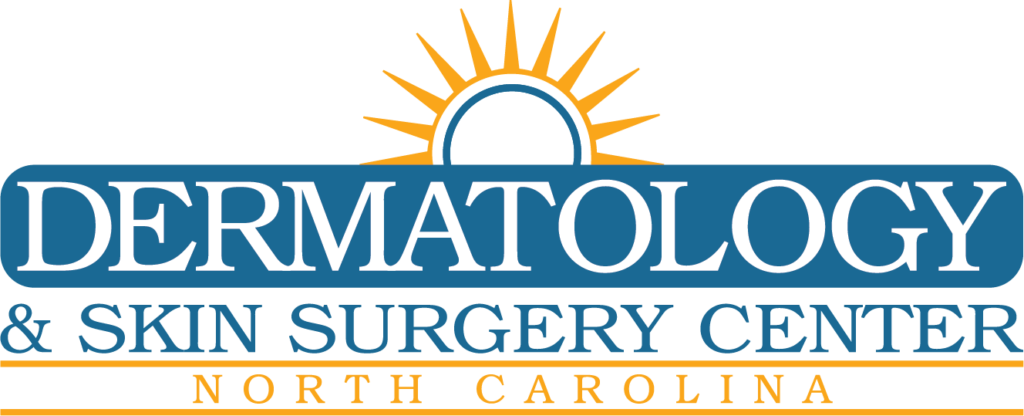Rosacea
Rosacea (pronounced “Ro-zay-sha”), which is also called Acne Rosacea, is a common skin disorder that affects more than 5% of the U.S. population. It tends to occur in patients between the ages of 30-55 but can occur in any adult patient. Women are affected more often than men. Rosacea tends to be a chronic disorder that requires treatment over time. Most patients can control their rosacea very well with proper treatment, but a true “cure” is not available at this time.
Rosacea tends to affect the mid face, and the nose and cheeks are the most common sites involved. The forehead and chin can be involved in some patients. Several features can be seen with rosacea, although most patients do not demonstrate them all. These features include redness, frequent flushing/blushing, papules (pink or red “bumps”), pustules (white or yellow “bumps”) and telangiectasias (small surface blood vessels). Progressive rosacea uncommonly results in enlargement of the nose (called rhinophyma) that can be significant.
The cause of rosacea is not known, but it tends to occur more frequently in patients with light colored hair and fair skin. Darker skinned people uncommonly get rosacea. Certain factors can contribute to rosacea though they do not “cause” the disorder. These include environmental stimuli such as heat, sunlight and sudden temperature changes. Emotional stimuli such as anger, stress or excitement can also trigger flare-ups. Hot and spicy foods (or drinks) can also affect rosacea as can alcohol intake.
Treatment
Treatment of rosacea is based on the extent of the patient’s particular case. There are a number of approaches available. First, patients should understand the factors that contribute to flare-ups (see above) and try to control those factors in their lives.
Daily treatment consists of:
- Wash your face GENTLY once or twice daily with a mild cleanser such as Aveeno, Neutrogena, Cetaphil, or White Dove cleanser.
- Apply a thin coat of a topical medicine (prescribed by your Provider) such as Metronidazole (e.g. Metrogel, Metrocream, Metrolotion, or Noritate) Finacea, Soolantra, or Elidel once or twice daily (after washing) to the areas of your face that are affected. If you ever get irritation from a topical product, simply reduce the frequency of application (e.g. 3-4 times a week instead of every single day) and gradually work up as tolerated. If you get continued irritation, call the office and report it. Oftentimes, changes can be made over the phone and don’t necessarily require an office visit. If needed, you are OK to use a gentle moisturizer on your face, and it is also OK to carefully use make-up, provided it does not increase irritation.
- Some patients are prescribed oral antibiotics. These products work more from the standpoint of INFLAMMATION reduction as opposed to simply antibacterial properties. Low dosages are often very effective. Such products include Minocycline (Solydyn), Azithromycin, Septra (or Bactrim) and Doxycycline (Oracea, Doryx). These should be taken as prescribed. If you experience any symptoms or signs that could be considered a side effect from your medicine (such as headache, rash, upset stomach, dizziness, flu-like symptoms etc.) you should immediately contact the office to discuss it. Likewise, if you become pregnant while on oral antibiotics, stop the antibiotic completely. If you are given a Doxycycline product or Azithromycin, you should take it with food typically (to decrease the possibility of stomach upset). Some of these antibiotics can cause increased sensitivity to sunlight, but they usually do not (especially in the low doses used for rosacea). If you find this to be an issue for you, notify the office so that adjustments can be made. If you are prescribed a Minocycline derivative (e.g. Solodyn), note that these antibiotics rarely cause dizziness. They also very rarely cause a drug rash that can be quite severe (e.g. hives, fever, joint pain etc.). If you were to get this type of reaction, it would typically occur during the first 2-3 weeks of taking the drug, though, as stated, this is quite rare. Notify the office promptly if you get these sorts of symptoms.
- Other various medications and/or approaches are sometimes involved in the treatment of rosacea. These might include an occasional Kenalog (mid strength steroid) shot (which is generally safe). Other modalities sometimes employed include Avar or Ovace or Plexion based products, Elidel cream, or Neosalus. In resilient especially difficult cases, lsotretinoin (e.g. Accutane, Absorica) can be used orally with good success.
It is important to realize that most treatment strategies start showing benefit in about 4-8 weeks. Be patient and do not get discouraged. Your provider will help you find a treatment plan that will control your rosacea! Click here to download this Rosacea information in PDF format.
